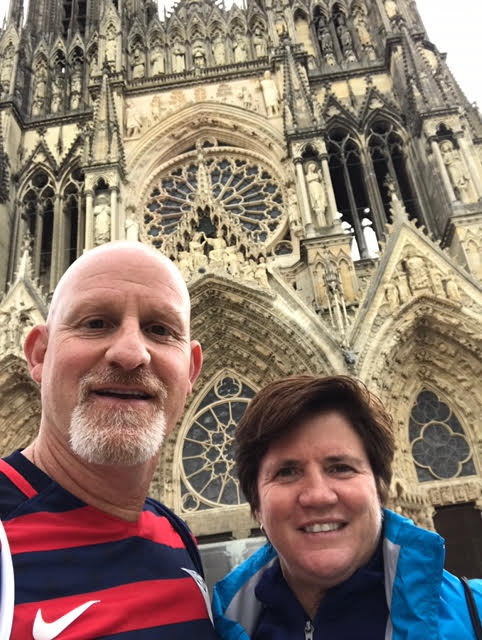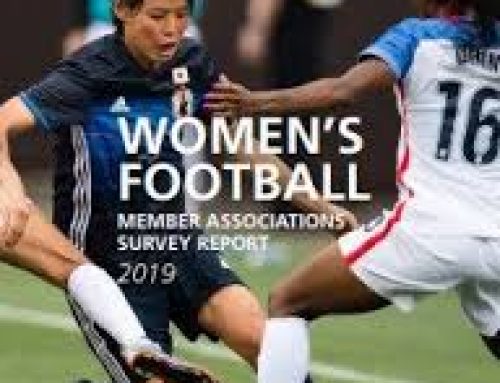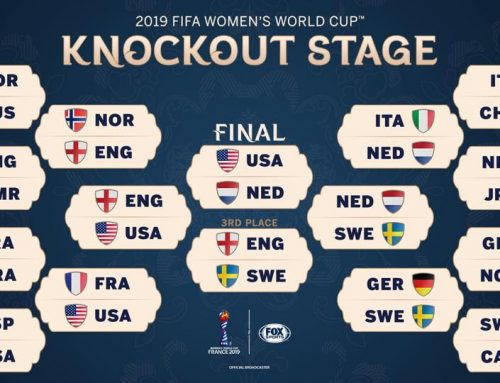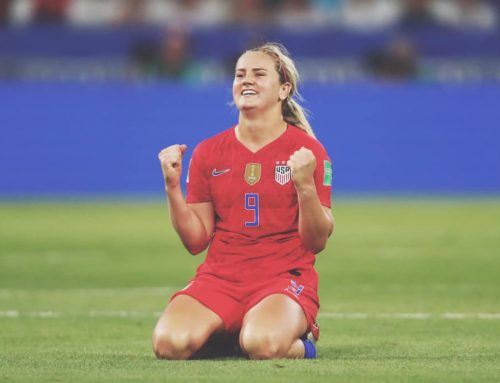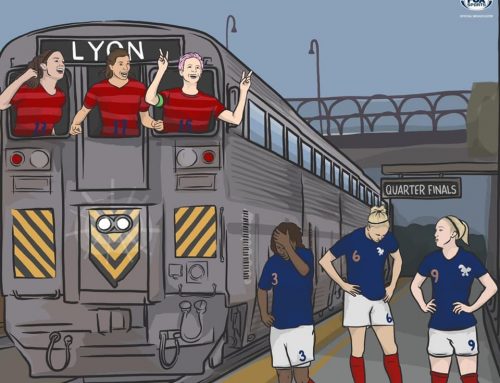I lived in Germany in 1989. That was 30 years ago and I’m going to use that as my reference point to Europe. I have worked (as a coach and director) in the women’s game in the US since the early 1990’s. I have hesitated to do too much reflection in writing partly because it takes time and I’ve been too busy absorbing. Plus, I want to get a more accurate pulse of the tournament before sharing my thoughts. It’s possible my opinions change a bit as the tournament unfolds and I have more experiences, watch more live games, etc.
The progress is obvious, when you look back to 1989. As it should be. Let’s not forget that in 1989, the inaugural 1991 Women’s World Cup had yet to even take place. This year we celebrate the 8th edition of the tournament. It happened and it continued, which is progress in itself, especially given the FIFA leadership at the time.
I’m sure many remember in 2004 (and other times I’m sure), then FIFA President Sepp Blatter suggested female players wear tighter shorts. Blatter, said women should have skimpier uniforms to increase the popularity of the game. “Let the women play in more feminine clothes like they do in volleyball,” he said. “They could, for example, have tighter shorts. Female players are pretty, if you excuse me for saying so, and they already have some different rules to men – such as playing with a lighter ball. That decision was taken to create a more female aesthetic, so why not do it in fashion?”
Obviously a ridiculous statement which offended all of us working in the women’s game at the time (men and women) but comments like that were the par for the course. FIFA was offering women’s soccer, but wasn’t really investing in women’s soccer in the same way it did the men’s game.
Despite this time of mentality from the top, the women’s game pushed forward. In Germany at the time (1989), women’s soccer wasn’t respected. The number of players, teams and clubs were young girls could play serious soccer was limited, and the collective attitude towards women’s soccer was not positive. I know this because I lived with a German family and the daughter was a talented soccer player, a member of the German Youth National Team system and one of the top players in her age group in the country. I saw the game through her eyes and the contrast between the opportunities that she had compared to her brother were disheartening. While he hoped and dreamed (and eventually achieved) becoming a professional, she hoped and dreamed just to be taken seriously.
Thirty years later, to be in Valenciennes watching Germany take on Spain in front of over 20,000 fans (girls, boys, women, men, German, Spanish, French, American) felt like a big step forward.
How do we look at progress in women’s soccer? For me, it starts personally and I sat down with my three women’s soccer experts recently to get their opinions. By experts, I mean my wife Renee (who grew up playing soccer and won a NCAA title in college), my daughter Sally (who is almost 20 years old, grew up playing youth soccer, played at Sonoma State University and has started to coach) and Gabby (who is 17 years old, grew up playing youth soccer and has committed to play college soccer at Concordia University in Portland). I’ve worked in a lot of roles in women’s soccer but I’ve never played women’s soccer, so while I can make assumptions, their perspective was more important than mine. Plus, I knew they would be honest with me.
It is important to understand that they grew up in a soccer family with two parents that played and that are actively involved in the game. Given this it is possible their experiences might differ from the average girls growing up. With that in mind, I was encouraged to hear both Sally and Gabby speak about their experiences as young female soccer players. Both felt like they had considerable support and opportunities to play and compete. Both felt like the organizations (youth soccer clubs Santa Rosa United, Sonoma County Alliance and North Coast FC, governing body NorCal Premier Soccer, and high school Sonoma Academy) provided equal opportunities for girls and boys. Both Sally and Gabby felt like they have always had coaches that supported them and their development. While both have had plenty of challenges along the way (injuries, setbacks, etc) they reflect fondly on growing up as a female soccer player in Sonoma County. As a father, coach and administrator, it obviously made me happy to know that they have had these opportunities and support. As they should. The conversation shifted into speaking more globally about soccer (FIFA) and as it often does, became a bit more negative and cynical. Money became the measuring stick and guided our conversation.
So, we are back to looking at progress. It might not be the best comparison, but the global growth in the women’s game reminds me a little bit of the growth of soccer in general in the US. Those of us involved in the game have been fighting for respect for years. Americans have often viewed soccer as an outsider and for many it still is. The media always pointed to the advertisement dollars and the TV ratings. And those of involved in the game were convinced in you supported it and invested in soccer, things would change. And it has. Those of us involved passionately defended the game and pushed the game forward at every chance. We have argued, fought, pleaded, lobbied and hustled to gain respect for soccer in the US. It has been a life mission for many of us involved. I see the same struggle for respect and equality in women’s soccer. Take us seriously. Invest in us. Treat us fairly and equally. Respect us.
I watched the US play in Reims earlier this week. And something happened which showed progress. It was actually a bit disheartening at the time, but upon reflection, it was encouraging.
We were together with 20,000 fans to watch the game. My guess was about 16,000 of them were Americans and many of those Americans walked the streets of Reims before the game. They traveled to France from all over the US (and world) to celebrate the US Women’s national team which has been a beacon of hope and pride. They have been dominant for years and many of the players have become household names, sponsor magnets and amazing role models for aspiring soccer players. The fans were young and old, male and female and the optimism and excitement was palpable as we toured this historic city.
At the picturesque Notre-Dame de Reims Cathedral, a couple approached me and the person (female) I was speaking with and asked if she would take a picture of them in front of the cathedral. Of course she said. I let them take the picture, then told them they should also take one with the person that just took the photo. And to trust me.
The person they asked to take their photo was April Heinrichs, team captain of the 1991 Women’s World Cup team. They eventually recognized her (as would any true women’s soccer fan) and I’m sure it was a funny moment when April would later be interviewed in the stadium on the jumbo screen. She is heading up the Technical Study Group for FIFA. April was one of my first female soccer idols. She inspired me personally in how I viewed the women’s game, but more importantly also inspired my wife and young girls who were playing at the time. I say “more importantly” because I had plenty of male soccer players to look up to, but April was the first generation of female players that you could watch and admire. She was a badass, so talented and so competitive. The stories about her are legendary, from her times at UNC to National Team. She was part of the group that put US women’s soccer on the map. No, April helped put the women’s soccer on the world map.
So, if I could fast-forward 30 years, it would be interesting to see if a fan would approach Alex Morgan, Megan Rapinoe or Carly Lloyd and ask them to take their picture, instead of taking a picture with them. My guess is given the number of commercials, endorsements these players have had and the amount of visibility and impact women’s soccer has made in the US, that likely wouldn’t happen.
I suppose that is progress, although for me personally, I am here not only to celebrate the current generation of Alex Morgan, Megan Rapinoe and Carly Lloyd but also the previous generations who have laid the foundation for all of us involved in soccer, especially on the women’s side.
Truth be told, shortly before this interaction, I had approached April to take a selfie like I do whenever I have the chance to meet an iconic athlete. She happily obliged.
Progress. Respect.
